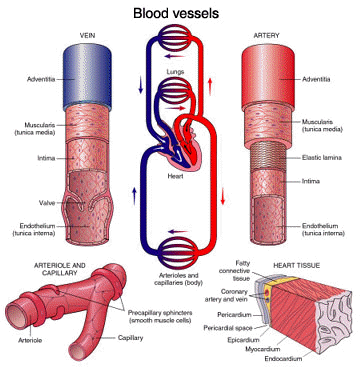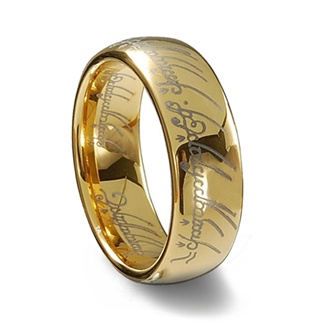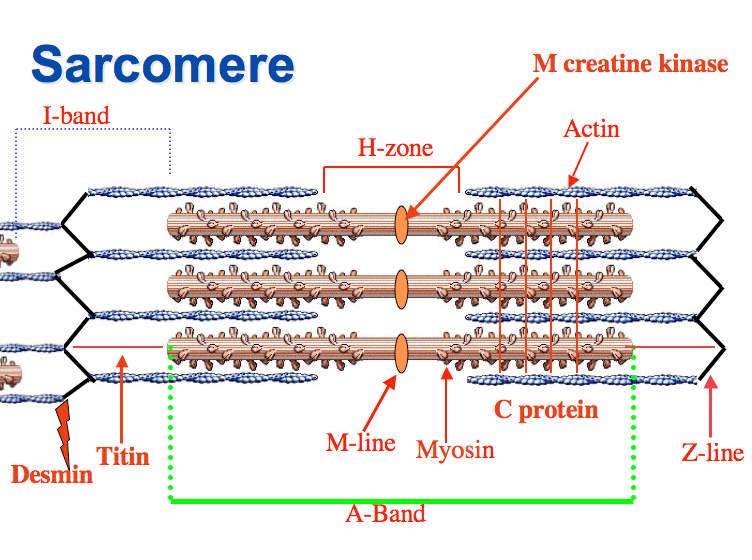Arteries - blood away from heart
Capillaries - exchange vessels
Viens - blood to the heart
The vessel wallTunica interna
Simple squamous epithelium or endothelium
Loose connective tissue
Tunica media - muscle layer
Smooth muscle and collagen fibers, some elastic fibers in arteries
Provides vasoconstriction and vasodilation
Tunica externa - gives the vessel it's round shape
Loose connective tissues that anchors vessel in place
 Arteries
ArteriesResistance vessels - maintain shape when empty or cut
Conducting or elastic arteries - large
Tunica media has many elastic fibers
Distributing or muscular arteries
Distribute blood to specific organ
Mostly smooth muscle
Usually have individual names
Resistance vessels
Smallest are called arterioles
Some end in metarterioles or precapillary sphincters (gate)
Arterial Sense OrgansMonitor blood pressure and blood chemistry and transmit to the brainstem to regulate heartrate, vasomotion, and respiration.
Carotid sinuses - baroreceptors in carotid artery and innervated by glossopharyngeal nerve to help adjust heartrate and blood pressure (monitors bp)
Carotid bodies - chemoreceptors in carotid artery that monitor carbon dioxide, oxygen and pH levels of blood, send signal via vagus and glossopharyngeal nerves to adjust respiration and kidney function
Aortic bodies - same as chemoreceptors in carotid bodies, but located in the aortic arch
CapillariesExchange vessels
Consist of only tunica interna
In every tissue except: tendons, ligaments, cartilage, epithelia, and the cornea and lens of the eye
Types of capillaries: (based on cellular junctions and permeability)
Continuous capillaries - BBB (Blood Brain Barrier), stomach lining
Fenestrated capillaries - most common, skeletal muscles
Sinusoids - more holes than cells, in hypothalamus and liver
Capillary beds
Thoroughfare channels - capillaries to arterioles
Tendons and ligaments are avascular so there is little blood supply to give nutrients and allow them to heal. This is why it takes less time for bones to mend than sprains or strains.
Also, the crazy German scientist who created Body Worlds that travels around the globe used a process called Plastination to keep the bodies the way they are. This works at an intercellular level allowing only blood vessels or muscles for example to be kept in place while all the other bodily tissues go away.
 Veins
VeinsCapacitance vessels - large capacity
Postcapillary venules - mostly tunica interna, somewhat permeable
Muscular veins - 1 to 2 layers of tunica media
Medium veins - have individual names and all tissue layers
Venous layers - many femoral valves (to prevent varicose veins)
Venous sinuses - normal varicose veins where blood is SUPPOSED to pool
Large veins
Mostly tunica externa
60% of our blood is in our veins @ all times because it is more difficult and takes longer for the blood to go against gravity back up to the heart from our limps.
Circulatory RoutesTypical route:
heart - arteries - capillaries - veins - heart
Exceptions to the typical route:
Portal systems
Anastomosis
Arteriovenule anastomosis - arteriole to venule
Arterial anastomosis - two arteries to one capillary bed
Venous anastomosis - more than one vein draining capillary beds




















